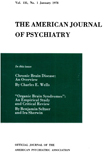EVALUATION OF COMBINED CORAMINE-ELECTROSHOCK THERAPY IN THE TREATMENT OF SCHIZOPHRENIA
Abstract
1. Thirteen schizophrenic female patients from among consecutive new admissions were given 5 c. c. coramine in conjunction with their regular series of EST, and a roughly comparable group of 13 patients received saline injections with their EST.
2. These patients were given the Wechsler-Bellevue Intelligence Scale and the Bender-Gestalt test just prior to their shock series and were retested 5 weeks following their last treatment.
3. Results indicate that EST used in conjunction with coramine significantly decreased the time spent in EST treatment. Patients receiving coramine returned to a higher level of intellectual functioning and more adequately perceived reality than did their controls as measured by psychological tests.
4. It is hypothesized that coramine-EST brings about an increased blood flow and thalamic stimulation occurs with most of the results being similar in quality, but greater in quantity, to those with standard EST. The one major qualitative difference noted in contrast with standard EST treatment was the lowering of inadequate defenses. The use of coramine-EST makes "intensivetreatment EST" for excited patients unnecessary, thereby avoiding the undesirable post treatment confusion and clinical organic symptoms.
5. Coramine-EST patients experience less fear and appear more receptive to psychotherapy. Acutely ill new admissions benefit most.
6. This is a pilot study and the results should be considered tentative in view of the size of our sample. A 2-year follow-up of these patients would be necessary to draw any definite conclusions as to the permanency of the effects of coramine-EST. The marked tendency in favor of the coramine-EST group does, however, warrant further investigation of coramine as a variation in EST.
Access content
To read the fulltext, please use one of the options below to sign in or purchase access.- Personal login
- Institutional Login
- Sign in via OpenAthens
- Register for access
-
Please login/register if you wish to pair your device and check access availability.
Not a subscriber?
PsychiatryOnline subscription options offer access to the DSM-5 library, books, journals, CME, and patient resources. This all-in-one virtual library provides psychiatrists and mental health professionals with key resources for diagnosis, treatment, research, and professional development.
Need more help? PsychiatryOnline Customer Service may be reached by emailing [email protected] or by calling 800-368-5777 (in the U.S.) or 703-907-7322 (outside the U.S.).



